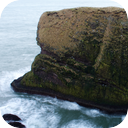(short preview of full seamless looping track)
Sea From The Clifftop
This product is not available in the selected currency.
In Stock
Backordered
Out of Stock
Description
You stand tall, long hair blowing in the salty wind, and stare down the cliff face, calling to your drowned ancestors, the ones who once sailed from this coast, casting off to find adventure, riches, and exotic rewards unlike any found on the familiar green hills of home. A thousand years later, you exalt their exciting stories while watching waves crash upon the rocks, and then you head home for some muffins and hot cocoa. In geography and geology, a cliff is a significant vertical, or near vertical, rock exposure. Cliffs are formed as erosion landforms due to the processes of erosion and weathering that produce them. Cliffs are common on coasts, in mountainous areas, escarpments and along rivers. Cliffs are usually formed by rock that is resistant to erosion and weathering. Sedimentary rocks are most likely to form sandstone, limestone, chalk, and dolomite. Igneous rocks, such as granite and basalt also often form cliffs. Some of the largest cliffs on Earth are found underwater. For example, an 8,000-meter drop over a 4,250-meter span can be found at a ridge sitting inside the Kermadec Trench. The highest cliff in the world, is Nanga Parbat's Rupal Flank, which rises approximately 4,600 meters, or 15,000 feet, above its base. According to other sources, the highest cliff in the world, about 1,340 m high, is the east face of Great Trango in the Karakoram mountains of northern Pakistan. The location of the world's highest sea cliffs depends also on the definition of 'cliff' that is used. The Guinness record books claim it is Kalaupapa, Hawaii, at 1,010 m high. Another contender is the north face of Mitre Peak, which drops 1683 meters to Milford Sound, New Zealand.
Opps
Sorry, it looks like some products are not available in selected quantity.



